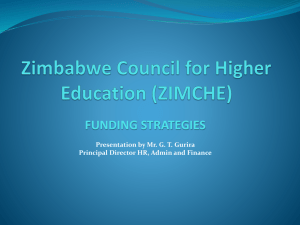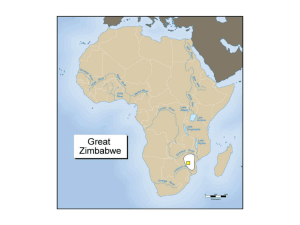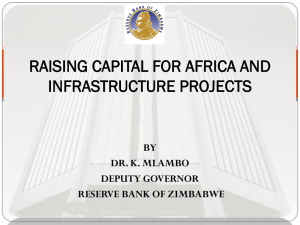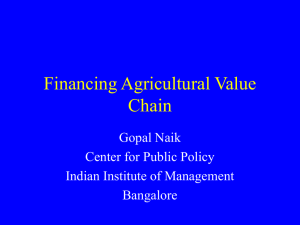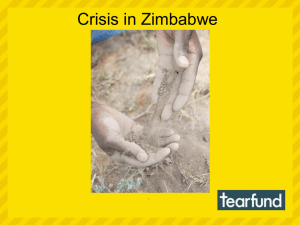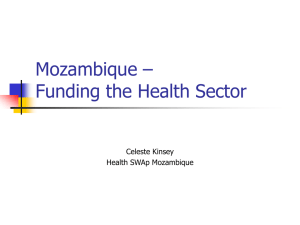IDBZ Mining Indaba Presentation 9 October 2014
advertisement
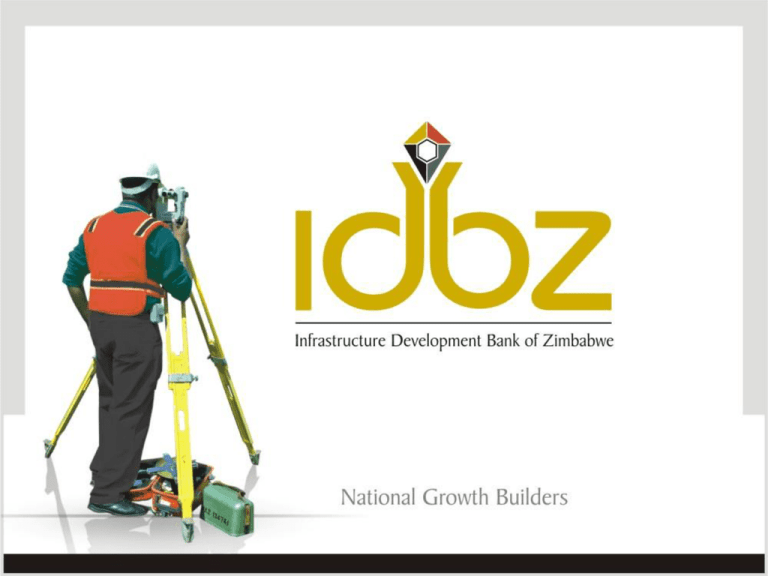
DEVELOPMENT OF INFRASTRUCTURE PROJECTS IN ZIMBABWE AND BEYOND – CASE STUDIES BY Des Matete Director Infrastructure Projects (IDBZ) at Zimbabwe Mining and Infrastructure Indaba Meikles Hotel, Harare 8-10 October 2014 CONTENTS • ROLE OF INFRASTRUCTURE IN ECONOMIC DEVELOPMENT • INFRASTRUCTURE FINANCING – THE GAP • FINANCING OPTIONS • FUNDING REQUIREMENTS AND OPTIONS • CONCLUSION ROLE OF INFRASTRUCTURE IN ECONOMIC DEVELOPMENT • Established positive correlation between GDP growth and the stock of infrastructure assets (Calderon & Serven, 2005) • Income and inequality declines with higher infrastructure quantity and quality. • Infrastructure development - highly effective to combat poverty. • Infrastructure - a key enabler for efficient resource allocation and export growth. • Studies established that improved access to safe water for instance has an additional positive impact on income equality. ROLE OF INFRASTRUCTURE IN ECONOMIC DEVELOPMENT • Infrastructure development connects domestic market of commodities and credit to international markets (including financial markets); • Infrastructure development improves the country’s competitiveness aiding local industry and attracting foreign direct investment; • Infrastructure investments lead to mobilization of latent resources and promotion of general economic development and growth; • Recent emergence of China as the world factory would not be possible without a range of new economic infrastructure services in place. Infrastructure Financing – The Gap • In 2008 Africa’s total infrastructure needs amounted to US$93bn with only US$45bn financed (Africa Infrastructure Country Diagnostic, 2008). • Zimbabwe requires approx.US$33bn in the next two decades (WB, 2012). At least US$1.65bn required each year for infrastructure development. • If Zimbabwe were to follow a growth path more akin to that of a middle country, estimates of the needs could be 20% higher than the baseline scenario i.e US$40bn in total over the next 2 decades (Lim & Pommerenke, 2012). Infrastructure Financing – The Gap • According to STERP II for the economy to recover to 1997 GDP levels, funding of up to US$45bn is needed. • Estimates for the Three Year Framework (2010-2012) period, taking into account the absorptive capacity, indicated requirements of some US$2030bn. • Over this period Govt. was expected to contribute between US$4bnUS$6bn – clearly an ambitious target. • AfDB estimated that the country requires about US$14.2bn at 2009 constant prices, including US$4.6bn of private investment in upgrade of existing infrastructure and new capacity from 2011-2020. FINANCING OPTIONS Sector National Budget State Enterprises Local Authorities Donors Private Total Water 1050.7 305.0 100.0 1287.5 1475.0 4218.2 876.2 2076.0 4328.9 584.8 966.0 5552.5 3.0 43.4 82.4 Power 1376.7 Transport 599.8 849.9 Communication 36.0 Total 1686.5 2531.6 2652.0 2751.5 4560.4 14182 Share % 12 18 19 19 32 100 Source: African Development Bank Report 2552.0 FINANCING OPTIONS Global trends - increased involvement of private sector in infrastructure provision. Most private sector investment channelled to ICT sector, which received 87% of investment commitments in 2008 (OECD, 2010). Innovative financing sources – local & foreign currency bonds, private equity, Sovereign wealth funds, PPPs, and emerging South partners. Good examples abound - Nelspruit Water and Sanitation Concession in South Africa helped raise access to water for houses in Mbombela Municipality from 55% in 1999 to 94% in 2010, (Brenden & Gibson, 2010). FINANCING OPTIONS (cont) Private sector participation in the infrastructure is enabled by collaborative effort between Private and Public sector through PPPs. Collaborative ventures in PPPs - built around expertise and capacity of the project partners. Founded on Contractual Agreement, which ensures appropriate and mutually agreed allocation of resources, risks, responsibilities and returns. PPPs - long-term, contractual partnerships between the public & private sector agencies, specifically targeted towards financing, designing, implementing and operating infrastructure facilities and services traditionally provided by the public sector. Some of the essentials of a PPP are: High priority, government planned project. The project must have emerged from a government-led planning and prioritization process Genuine risk allocation. Shared risk allocation is a principal feature of a PPP project Mutually valuable. Value should be for both sides, which means Govt. should also genuinely accept some risks and not transfer the entire risk to private sector, and vice versa FINANCING OPTIONS (cont) Forms and Formats of PPPs: The most common options are • • • • • • Service Contract Management Contract/Lease Built Operate Transfer (BOT) Build Own Operate Transfer (BOOT) Concession Joint Venture Most contracts take the form of Concession and Design, Build, Finance and Operate contracts to cover the finance, design, management and maintenance obligations. FINANCING OPTIONS (cont) Key Success Factors for PPPs • Enabler and Facilitative role for Government; • Governance structure ensures consumer + public interests are safeguarded; • Commercial interests protected for private sector party (tariff/return); • Domicile/Place risks to parties that are well equipped to deal with them; • Transparent + well conceived contracts (negotiate terms to best advantage); • Documentation recognizes rights and responsibilities of all parties • Concerns of all stakeholders addressed; • Technology + Knowledge Transfer (Capacity building for public sector operator) Case Studies- Africa Case Studies • The Nelspruit Water and Sanitation Concession in South Africa helped raise access to water for houses in Mbombela Municipality from 55% in 1999 to 94% in 2010, (Brenden & Gibson, 2010). • Infrastructure bonds - very successful in other African economies like Kenya. Since February 2009 bonds worth US$1bn issued, (AfDB, 2009). • Ghana issued a sovereign bond in 2007 worth US$750mil. Zambia in 2012 issued its inaugural sovereign bond raising US$750mil from international investors (oversubscribed). Case Studies - Africa • Zambia’s inaugural sovereign bond sale follows in the footsteps of Nigeria, Namibia and Angola. Ghana, Gabon, Senegal and Republic of Congo have also issued Eurobonds in recent years. • Diaspora bonds - pioneered in Ethiopia as Millennium Corporate bonds. These targeted Ethiopians (abroad & at home) to raise funding for the state owned Ethiopian Electric Power Corporation. • WB estimates that SSA countries could rise up to US$5-10bn per year through such bonds. Diaspora bonds are a potential source for future long term funding for infrastructure especially in Zimbabwe given Diaspora population estimated at above 2million. Case Studies – IDBZ Projects • Raised a US$30mil bond for Energy – ZETDC prepaid metering project through our instrument, the Infrastructure Development Bond (IDB Bonds) • Housing projects; Waneka – Phase I- 72 units; Phase II- 216 Units (Jv with CoH); Willovale Flats; Mbizo 22 in Kwekwe; • Government projects under IDBZ management: Tokwe Murkosi; Mtshabezi Pipeline; Gwai Shangani; Wenimbi & Bubi Lupane. Harare International Airport + J.M Nkomo Airport State Universities Housing/Accommodation projects Project Development Process For successful infrastructure funding projects need to be developed to bankability: Necessary steps to develop projects to bankability: Project Identification Prefeasibility Study Feasibility Study Project Appraisal Project Preparation and Packaging Project Fundraising Financial Closure Project Development Process KEY Challenges Lack of funding for project development; Skills gap for project preparation and packaging; Lack of supportive specialised institutions that support Private Sector Participation in infrastructure development; Project Development Funding NEW Solution SADC Project Preparation & Development Facility (PPDF) SADC Regional initiative to provide funding for project development. DBSA appointed Fund Mgr & Implementing Agent Qualifying projects: • Transport (road, rail, shipping, ports & border posts) • Energy (generation, transmission & distribution; renewable energy) • ICT (including telecommunications) • Water & Sanitation • Tourism infrastructure (trans-frontier parks) Project Development Funding cont/… NEW Solution • • • • • • Eligible Costs Pre-feasibility studies Feasibility studies Economic & financial analysis costs Detailed design costs Tender preparation costs Legal & transaction advisory services costs Minimum grant of US$250k Beneficiary contribution – minimum 5%of total preparatory activity costs Window opened 1st September 2014 & closes on 30th October 2014 CONCLUSION • • • • Improvement in operating environment; Review regulatory framework governing various infrastructure sectors; Viable tariff setting for sustainability of infrastructure ventures; Strengthening of PPP Framework through an enactment of legislation • Setting up grant funding for project preparation and packaging; • Promote syndication arrangements among financial institutions both domestic and international for infrastructure development (capacity). • Adequately capitalised DFIs that focus on infrastructure so they play a pivotal and direct lending role to infrastructure development. References • Calderon, C. A., & Serven, L. (2005). The Effects of Infrastructure Development on Growth and Income Distribution in Chile. New York: World Bank. Retrieved October 8, 2014, from http://wwwwds.worldbank.org/servlet/WDSContentServer/WDSP/IB/2004/09/21/00 0012009_20040921105044/Rendered/PDF/WPS3400.pdf • Lim, J. and K. Pommerenke, 2012: Financing and Investment in the Aftermath of Hyperinflation, Zimbabwe Growth Recovery Notes Series, Note V, World Bank. • World Bank, 2012: From Economic Rebound to Sustained Growth, Zimbabwe Growth Recovery, Note 1 Overview, November 2012, • Ministry of Finance, 2009: Short Term Economic Recovery Programme (STERP), Ministry of Finance, Government of Zimbabwe • Ministry of Finance, 2010: Three Year Macroeconomic Policy and Budget Framework 2010-2012 (STERP II), Ministry of Finance, Government of Zimbabwe. STATUS OF THE POWER SECTOR IN ZIMBABWE Current Status Installed Capacity(Mw) HPS KSPS Munyati Bulawayo Harare Total Available (Mw) 920 750 120 90 450 750 60 60 90 1,970 30 1,350 Peak Demand – 2,200 (Mw) Generation Projects PROJECT DESCRIPTION Kariba South Extension 2 x 150 Mw generating units (7 & 8). Hwange Expansion Construction of 2 x 300 Mw generating units (7 & 8) Gairezi Hydro-Power 2 x 15 Mw generating units, on the Gairezi River. Batoka Hydro-Power (Bi-lateral with Zambia) 4 x 200 Mw generating units along Zambezi River COST (in USD STATUS millions) 539 1,800 105 Under implementation. At contracting stage Placed on tender. 2,200 – 4,000 Bi-lateral engagements and final reviews of feasibility study TARIFFS • Our tariffs per power station: Hwange - USc 8.14/kWh Kariba - USc 2.35/kWh Small Thermals – USc16/kWh Average bulk supply tariff from ZERA Usc 5.06/kWh Our blended tariff USc 7.35 /kWh (may be considered uneconomic, competitive on parity) Regional average Usc 9.13 /kWh I THANK YOU
